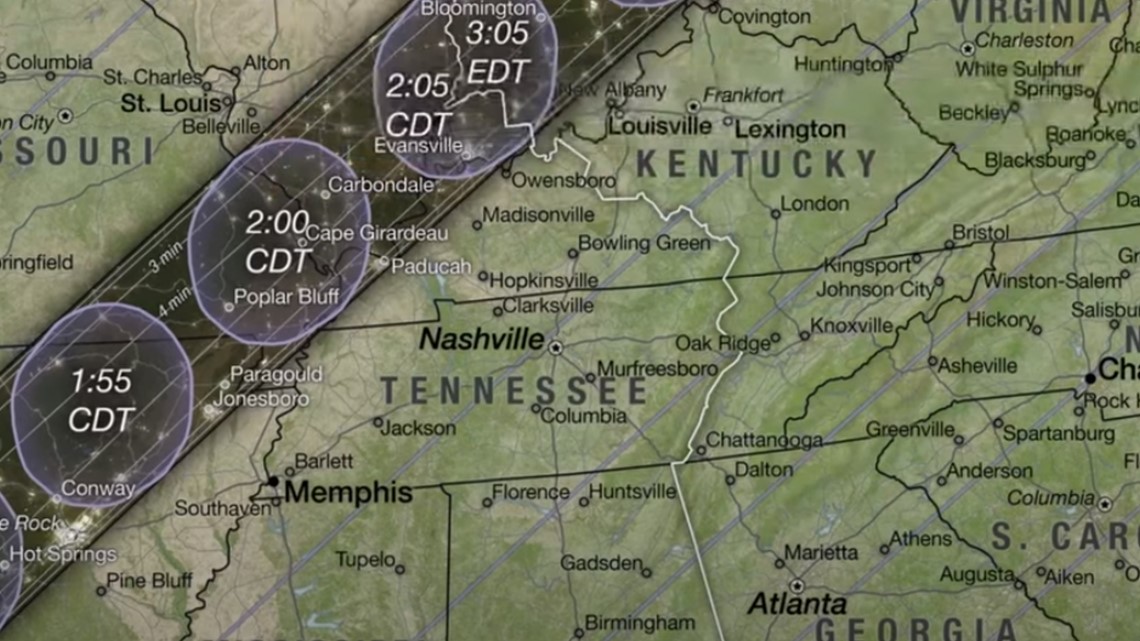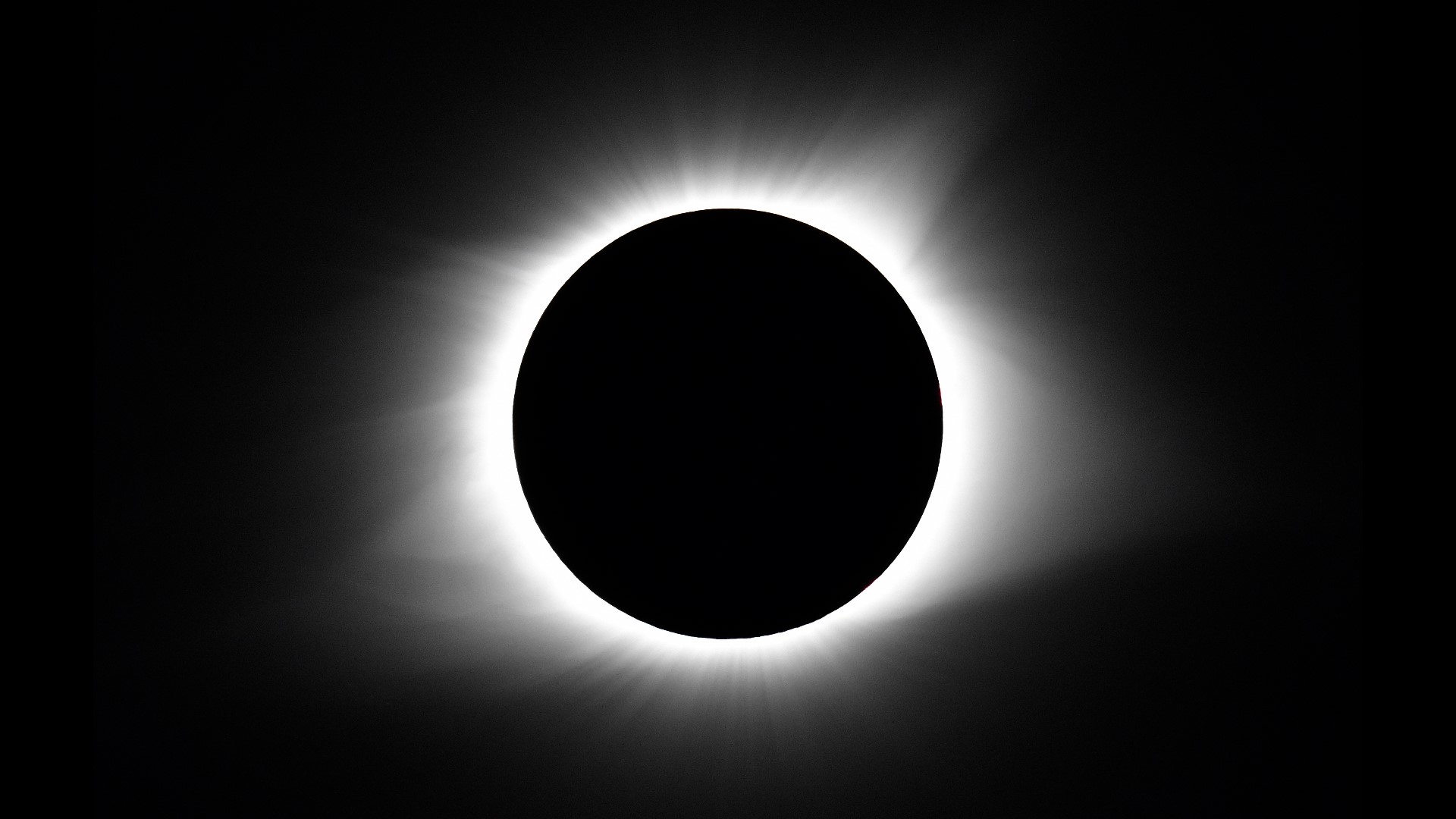KNOXVILLE, Tenn. — Get ready -- there's a total solar eclipse coming to America in April.
If you miss it, you're going to have to wait at least two decades to get another chance to see one in the U.S., because the next total solar eclipse in the contiguous U.S. will be in 2044!
The 2024 Great American Eclipse will pass over the U.S. from Texas to Maine on the afternoon of Monday, April 8, 2024.
Will this be like the 2017 Great American Eclipse?
For East Tennessee and Southeast Kentucky, unfortunately not. The path of totality will be to our west this time, so we won't see a true total solar eclipse like we did in 2017.
Thankfully, it's not a total bust! The path of totality skirts the far-western edge of our states and passes over West Kentucky, Central Arkansas and Southeast Missouri -- so we will still see a good bit of the sun partially eclipsed by the moon from our vantage point.
How much of an eclipse you will see will depend on how close you are to the path of totality, which is the shaded line below.
►Related Story: Total solar eclipse to cross over the U.S. in 2024


What time will the eclipse happen?
If you are in Tennessee or Kentucky, you will want to head outdoors and keep your eyes on the sky starting around 1:35 p.m. EDT on Monday, April 8. That's when the moon will begin partially eclipsing the sun moving from the southwest from Texas toward the northeast toward Maine.
The Knoxville area will see the partial eclipse begin just before 1:50 p.m. and hit its peak a little after 3 p.m. Here are the eclipse timetables for Tennessee's three Grand Divisions:
Knoxville/East Tennessee
- Partial eclipse begins: 1:49 p.m. EDT
- Maximum eclipse (~88% eclipsed): 3:07 p.m. EDT
- Partial eclipse ends: 4:23 p.m. EDT
Nashville/Middle Tennessee
- Partial eclipse begins: 12:44 p.m. CDT
- Maximum eclipse (~95% eclipsed): 2:03 p.m. CDT
- Partial eclipse ends: 3:20 p.m. CDT
Memphis/West Tennessee
- Partial eclipse begins: 12:37 p.m. CDT
- Maximum eclipse (~98% eclipsed): 1:57 p.m. CDT
- Partial eclipse ends: 3:15 p.m. CDT
Where should I go if I want to see the total eclipse?
One of the closest cities within driving distance to Knoxville in the path of totality is Paducah, Kentucky. The partial eclipse will begin there around 12:42 p.m. CDT and totality will occur around 2:00 p.m. CDT. It's on the edge of the totality path, so the total eclipse will be a couple of minutes shorter compared to cities in the center of the path.
It's not too rough of a drive. You just need to take I-40 West to Nashville and then head up I-24. Without traffic, it takes roughly four and a half to five hours to drive there from Knoxville. However, you should expect plenty of traffic that day from other people wanting to see the total eclipse -- so plan ahead. Several hotels are already booked up in the Paducah area as of Feb. 10.
The city of Paducah is banking on lots of people showing up to catch the eclipse. It will be holding a festival downtown the Sunday before the eclipse as well as on Monday, and it will host a viewing party along the Ohio River riverfront on the lawn of the National Quilt Museum. You can find out all the events at the Paducah Convention and Visitors Bureau website at this link.
Driving a little further into the center of the path of totality to someplace like Carbondale, Illinois or Cape Girardeau, Missouri will give you a longer view of the total eclipse.
Alternatively, East Tennesseans can drive north on I-75 to Ohio to experience the total eclipse. Cincinnati is just outside the path of totality, so you will need to head further north to Dayton to see the real deal. The drive is a straight shot on I-75 and roughly the same distance as Paducah -- taking about four and a half hours.
How to safely watch the eclipse
This should go without saying, but please do not stare directly at the solar eclipse without proper eye protection! It is not safe and the sun could seriously damage your eyes.
If you are looking to buy eclipse glasses, make sure they comply with the ISO 12312-2 international standard. Regular sunglasses will not safely cut it. Also, beware of counterfeit glasses sold online that falsely claim they meet the safe standards.
"We do not recommend searching for eclipse glasses on Amazon, eBay, Temu, or any other online marketplace and buying from whichever vendor offers the lowest price. Before you buy a solar viewer or filter online, we recommend that you make sure that (1) the seller is identified on the site and (2) the seller is listed on this page," the American Astronomical Society said.
The American Astronomical Society has a list of verified suppliers and sellers at this link that comply with safe standards.
When is the next total eclipse in the U.S.?
Put a pin in your calendar for Aug. 23, 2044, and make travel plans to Montana or North Dakota. This will be a particularly special eclipse because it will occur later in the evening closer to sunset. We'll be blessed that decade with a second solar eclipse that crosses over a good swath of the Southern U.S. in 2045.
The next time a total solar eclipse passes over East Tennessee... well, it won't happen in anyone's lifetime today unless a recent newborn somehow lives to the ripe old age of 129. Those who do live to see the day will be waiting until Oct. 17, 2153!


